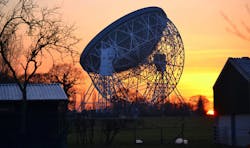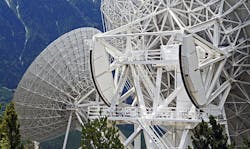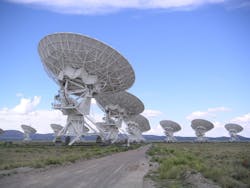Radio telescopes are just enormous sensitive broadband receivers that use some of the most advanced wireless technology. You’ve probably heard of radio telescopes, but do you know how they work and about some of the extreme radio technology involved?
Most people know telescopes as optical instruments for looking at things far away. Well, a radio telescope is the same thing. Instead of looking for light, it looks for radio waves. We can now visually see what appears to be an infinite number of stars, planets, and galaxies with an optical telescope. But that’s not all. Lots of other things out in space we simply cannot see. The reason for this is that dust and clouds out in space block a huge amount of the light in the universe. Yet radio waves penetrate right through the clouds and dust as well as the earth’s atmosphere.
As it turns out, almost everything in space seems to emit electromagnetic waves. Remember, the electromagnetic spectrum runs from dc though radio waves, then transitions into an infrared region followed by visible light. As we go higher in frequency and shorter in wavelength, ultraviolet waves come next followed by x-rays, gamma rays, and so on. You can think of radio waves as a very low frequency light. Or consider light as an extremely high radio frequency.
Infrared waves come from heat. Any object that emits heat at any temperature above absolute zero (−273°C) emits radio waves. The stars, planets, ionized gases, and galaxies all emit radio waves. The signals are extremely weak as they reach us over a vast distance. Even at the speed of light—300,000,000 meters per second (186,400 miles per second)—it takes light years for remote space signals to reach us. But if we can build a sensitive-enough receiver, we can pick them up, study them, and try to make sense of what happened in the past out there in space.
Extreme Receiver Technology
A good sensitive receiver begins with a great antenna. Radio telescope antennas need to be big and with high gain and narrow beamwidth to convert those tiny signals from space into electron flow we can capture and process. Most radio telescopes feature a huge parabolic dish. The largest are hundred or more feet across.
The dish size or aperture determines the gain of the antenna and its lowest frequency of usefulness. The big dishes have mechanical systems for rotating them in azimuth and elevation. The big dish focuses the incoming waves into a concentrated beam at the focal point, where an antenna translates the weak signal into a voltage that can be amplified.
By the way, the unit of measurement of the signal strength in radio astronomy is called the jansky, named after Karl Jansky, who was the first scientist to discover radio waves from space. One jansky is 10−26 watts per square meter per hertz. How’s that for weak signals?
Most advanced wireless receivers begin with a low-noise amplifier (LNA). Noise is the main enemy of weak radio signals, as it can mask them completely if the noise level is too high. Despite their name, LNAs also add noise to a receiver. Most of that is thermal noise caused by heat, which energizes atoms and electrons into a random signal. You may have learned somewhere that the thermal noise voltage is:
Vn = √(4kTBR)
T is the temperature in Kelvins (K) or Celsius + 273, B is the bandwidth in Hz, R is the resistance of the component contributing the noise, and k is Boltzmann’s constant or 1.38 × 10-23.
In a radio telescope receiver, the LNA is cooled by cryogenic methods to a temperature close to absolute zero (4K). The receiver front-end (LNA, mixer, and antenna probe) is housed in a vacuum-sealed package and cooled by liquid helium. That’s a low-noise amplifier!
The amplifiers also use special components such as transistors and integrated circuits made of materials that work best at microwave and millimeter-wave (mmWave) frequencies. Examples include heterostructure FETs and BJTs, as well as high electron mobility transistors (HEMTs) made of gallium arsenide (GaAs) and indium phosphide (InP).
Once the signals get some initial amplification, they’re usually downconverted in a mixer to a lower frequency, usually in the 1- to 10-GHz range, before detection in a Schottky diode. The detected signals are digitized and stored, then converted into color visual images that help explain their nature. Because remote space signals are relatively constant, they can be continually monitored and averaged to boost signal-to-noise (S/N).
The Very Large Array (VLA) setup in New Mexico. (Courtesy of Wikipedia)
It’s a consistent challenge to get high gain at the upper mmWave frequencies. One solution has been to omit the amplifier and send the antenna signal directly to the mixer that downconverts the signal to a lower frequency, where lower noise gain is easier to get. The related challenge is making low-noise mixers. That problem has been solved for now with a special mixer known as a superconductor-insulator-superconductor (SIS) mixer, whose nonlinearity comes from quantum tunneling between the two superconductors.
In the past, most radio telescopes used the single huge dish antenna. It can cover a wide frequency range and the gain is enormous and the directivity is narrow. In the older original designs, the receiver was located at the focal point of the dish to get amplification before other parts of the system add noise. Today it is more common to put a reflector at the focal point that directs the signal to the center of the dish where the heavy receiver unit with its cryogenic components can be more securely mounted.
A growing trend is to make multiple smaller (< 25m) dish antennas and arrange them in a mobile array whose combined output is just as good if not better than that from a single large dish. An example is the Very Large Array (VLA) in New Mexico. It uses 27 dishes each with a diameter of 25 meters. One application is to connect two or more antennas to the receiver at the same time to implement interferometry, a collection of techniques that superimpose the signals to improve resolution.
A major part of a radio telescope installation is the computational power. All received signals are digitized and stored and subjected to a wide range of advanced processing techniques. Processing power is impressive as the CPU, FPGA, or other device must compute Fourier and other analysis on large floating-point numbers. Rates up to 750 billion floating-point operations per second have been reported.
Frequencies of Interest
Radio signals from space have frequencies of a few megahertz up to 1 THz. Most are in the hundreds of megahertz or gigahertz range. Some of the signals come from thermal sources, but others are emitted at a single frequency. The earliest signals detected were in the 160-MHz range. Major finds also occurred at 178 MHz. A powerful non-thermal signal comes from hydrogen—the universe is loaded with hydrogen and it emits a very narrow signal at 1420 MHz (21 cm). Astronomers have made big sky surveys at 5 GHz. Some FCC/NTIA protected frequencies are 10.7 GHz and 15.4 GHz. Ammonia molecules were detected at 22 GHz. Carbon monoxide (CO) was discovered at 115 GHz.
Space signal sources can have many frequencies. As a result, good radio telescope receivers must maintain a wide tunable frequency range. The newer systems are being developed to receive the higher mmWave signals. There’s a movement to push the technology to 1 THz.
The Truth About Radio Telescope Applications
Scientists use radio telescopes to study the universe with its enormous number of stars (suns), planets, moons, galaxies, and weird sources like pulsars, quasars, and black holes. Astronomers can measure the frequency of the signal that can change if the source is moving toward or away from the receiver. By using the Doppler principle, they can make amazing speed and distance measurements.
Because of their versatility, big radio telescopes have also been used in projects other than space mapping. Monitoring far distant space craft is one application. They can function as a backup to almost any space activity: moon exploration, Mars monitoring, shuttle and space-station communications and satellite monitoring. And, of course, there’s SETI (search for extraterrestrial intelligence).
Shown is the massive radio telescope in Arecibo, Puerto Rico. (Courtesy of Wikipedia)
New radio telescopes continue to be built. Many are multiple dish arrays. However, the trend of building larger dishes is growing. The largest radio telescope in the U.S. is at Arecibo in Puerto Rico. It’s a massive 305-meter spherical dish built into a valley. China now owns the largest radio telescope with a dish diameter of 500 meters. No telling what it will be able to “see.”
New receivers reaching to 950 GHz with SIS mixers, HEMT LNAs, and the cryocooling make radio telescopes extreme technology. The military probably uses some extreme technology we don’t know about. How would we use that technology if it could be brought to the commercial sector? Any ideas? How about a cryocooled cellular base station. Think about it. Then again, maybe not.
About the Author
Lou Frenzel
Technical Contributing Editor
Lou Frenzel is the Communications Technology Editor for Electronic Design Magazine where he writes articles, columns, blogs, technology reports, and online material on the wireless, communications and networking sectors. Lou has been with the magazine since 2005 and is also editor for Mobile Dev & Design online magazine.
Formerly, Lou was professor and department head at Austin Community College where he taught electronics for 5 years and occasionally teaches an Adjunct Professor. Lou has 25+ years experience in the electronics industry. He held VP positions at Heathkit and McGraw Hill. He holds a bachelor’s degree from the University of Houston and a master’s degree from the University of Maryland. He is author of 20 books on computer and electronic subjects.
Lou Frenzel was born in Galveston, Texas and currently lives with his wife Joan in Austin, Texas. He is a long-time amateur radio operator (W5LEF).




